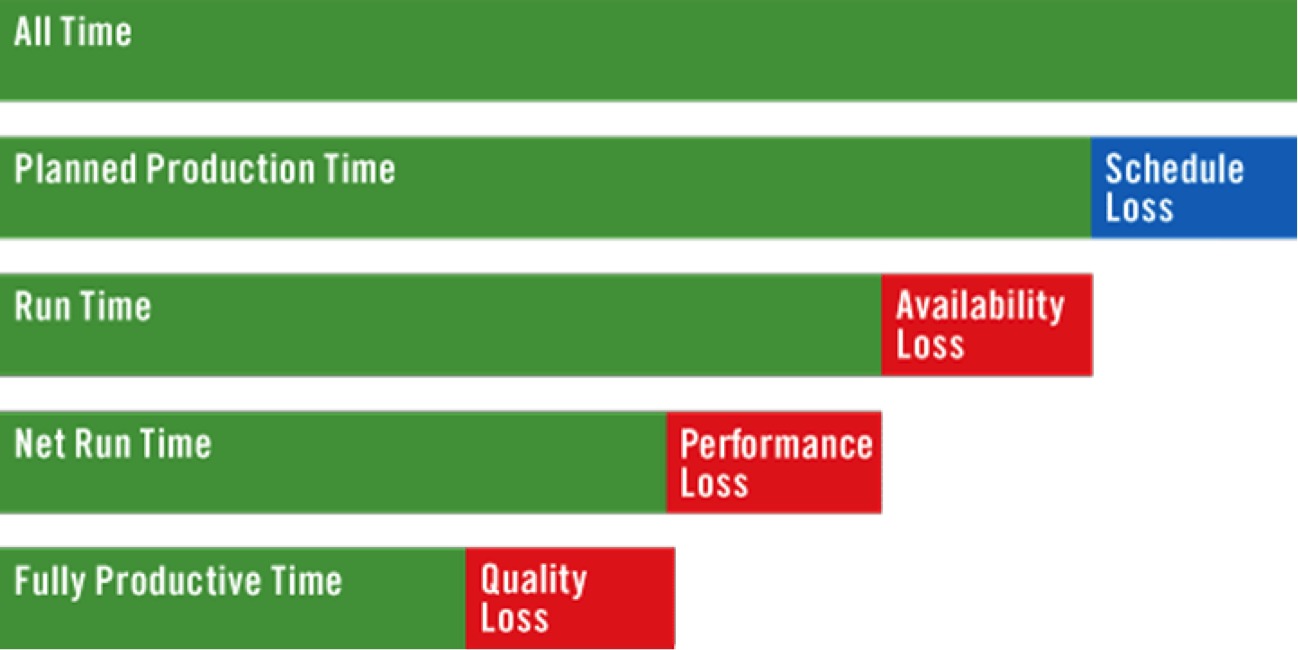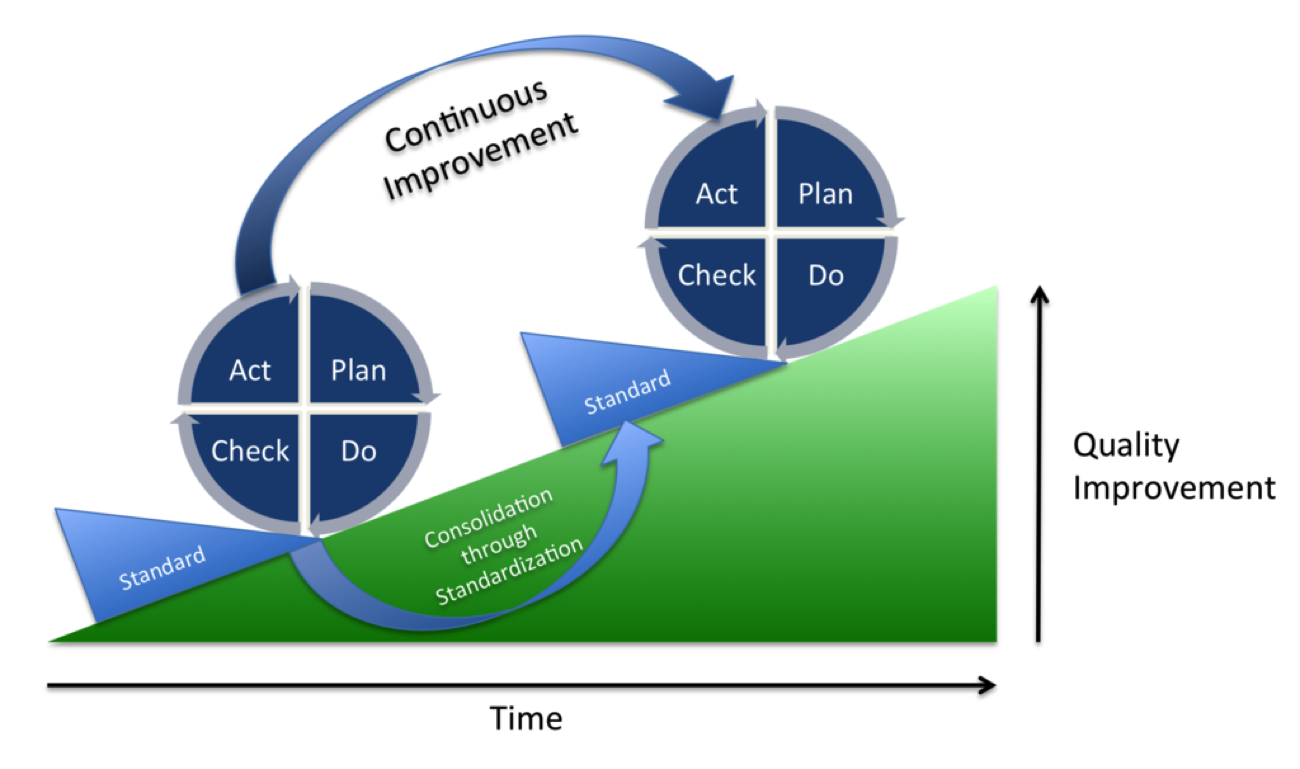Equipment availability is a metric used to measure the percentage of time a machine can be used. It is the amount of time in which a machine actually runs and is available for production. Availability can also be called ‘uptime’, and it is one of the key metrics that give us insight into our production efficiency. Equipment availability could also be thought of as the probability that a machine is not experiencing any downtime, planned or not.
Understanding Availability
Availability is part of a larger concept and manufacturing metric called Overall Equipment Effectiveness. OEE is one of the many manufacturing metrics all plant owners and workers should pay attention to. OEE combines several performance indicators into a single score that tells us how well our plant is performing. OEE is an eye-opener into efficiency and therefore should be considered when aiming to improve your operations.
OEE takes into account three different factors into its calculation. These are: Availability (which is what we are discussing in this article), Quality, and Performance. Quality is defined as the portion of saleable units out of all units produced. It is the percentage of units or products that were produced without any defects and are acceptable by customers. Performance is the speed at which a machine runs compared to its fastest-possible or ideal speed.
Availability is what sets path for other factors, such as Performance and Quality. If you have machines with little availability and low production times, you will have less time and opportunities for high Performance and Quality. High Availability means less downtime and more throughput. Low downtime and high throughput is a synonym for high efficiency and good use of your plant’s machinery. High Equipment Availability provides you with a sufficient production run time to generate profit. When machines are running and being used, money is being made. Therefore, a successful manufacturing plant must have high availability.
Availability, however, depends on the amount of downtime your machinery experiences. These downtimes can be planned (maintenance and adjustments) or unplanned (break down or factory shutdown), but they all happen while machines are supposed to be up and running. These downtimes are called “Availability Losses”, and reducing these as much as we can is what will keep Equipment Availability high.
How do we prevent downtime from happening? The first step is tracking downtime. The next is to start to look for ways to reduce downtime. We have written a lot about downtime and the steps to prevent it, but maintenance is the most important step to take when dealing with machinery. To lower the chances of machinery failing, resulting in downtime, companies should perform periodic maintenance. Maintenance teams and routines can have huge positive effects in increasing availability and achieving success. The maintenance of machinery is heavily influenced by two characteristics: Reliability and Maintainability.
Reliability and Maintainability are two important concepts we should understand in order to treat machines, reduce downtime and increase Availability.
Reliability is the probability of a machine functioning without any failure during a specific amount of time. It is how much confidence and assurance a certain machine gives to the workers surrounding it that it will work. Reliability can also be thought of as the absence of unplanned downtime, such as machines failing. A high Reliability will contribute towards a high Availability, as it means more time of a machine running and processing materials. Reliability is increased by maintenance. In order to have a machine that is capable of working for hours, it needs to be in good condition. If good conditions are not achievable through maintenance, then replacement becomes the next option to go to. However, if a machine has the capability of functioning well, we must try to keep it like that.
The ease of performing maintenance on a certain object is driven by Maintainability. Maintainability is the the ability to maintain or restore a piece of equipment to its functioning state. It tells us how easy it is to identify a problem within a piece of equipment and how easy it is to solve it. As you may be able to picture by now, maintainability has a direct effect on Reliability and Availability. Lower Maintainability means a harder maintenance process, more time fixing an item, larger downtime because of longer maintenance, and more frustration for workers and maintenance teams. In contrast, a high maintainability translates into a fast and easy process to fix an item and improve its Reliability, which simultaneously improves Availability.
As you can see, Maintainability is a very important element for such an important manufacturing metric as Equipment Availability. How do we get a higher Maintainability throughout our production plant? Training and communication with employees helps a lot. Plant workers must understand the machine they handle, and should know how to identify a problem a machine may present. Plant workers should also be quick to communicate any problems they encounter so that maintenance can be done as soon as possible. A set troubleshoot plan, which aims to find the root cause of a breakdown, should be set in place. Strategies such as checklist and real-time tracking technology can help in collecting data and analyzing downtime causes. A good layout and structured plan for operations and inventory handling inside a production plant will facilitate mobility and help workers get to a site of interest much faster. Also, companies should not only perform maintenance when machines break down, but constantly perform checks called ‘Preventive Maintenance’. Preventive Maintenance is the act of inspecting your machinery periodically, looking for defects and performing required cleaning, lubrication, adjustments and wearing parts replacement. This will not only let you catch any irregularities and prevent any unplanned downtime before they happen, but will also keep you familiarized and knowledgeable with the machinery used at the production plant.
If these measurements are taken, Equipment Availability will rise. As we have stated, a high Equipment Availability will translate into a higher OEE, a higher throughput, and generally a larger profit. Higher Availability provides us with more production run time, which will let our production plant’s workers figure out ways to improve other important KPI’s to achieve a balanced production efficiency.
It is important to note that Availability is calculated based on a Planned Production Time. Planned Production Time is the amount of time a plant is meant to be actively manufacturing. The amount of time where a plant is not planned to be producing is called ‘Schedule Loss’. Therefore, when considering planned downtime when calculating Availability, only those maintenance or adjustment events that take place during normal manufacturing hours should be considered.

(Source: Worximity: Know Your OEE Terms)
The comparison of our Fully Productive Time to our Planned Production Time is a reflection of our production plant’s OEE. The greater the difference between Planned Production Time and Fully Productive Time, the lower our OEE and therefore our plant’s efficiency.
Once ‘Availability losses’ are considered in the Planned Production Time, we get our Run Time. This is the actual time that machines are actively manufacturing.
Each of these factors are linked to two ‘losses’.
These losses are circumstances, errors and negative events that take away from having a fully efficient production plant. A machine may seem to be 'available', but if it's not producing a quality product because it needs to be 'run in' or calibrated or adjusted as it starts, or if there are small starts and stops that aren't accurately measured then you have other losses to contend with.
Quality losses are production and startup rejects, which account for defective parts.
Performance losses are small stops and slow cycles during production.
Then, Performance and Quality losses take from this total run time to leave us with a Fully Productive Time that is usually much shorter than the Planned Production Time.
Want to understand your OEE? Download our Free OEE calculator
To see an example of an OEE calculation, see the related blog How to Calculate OEE.

















